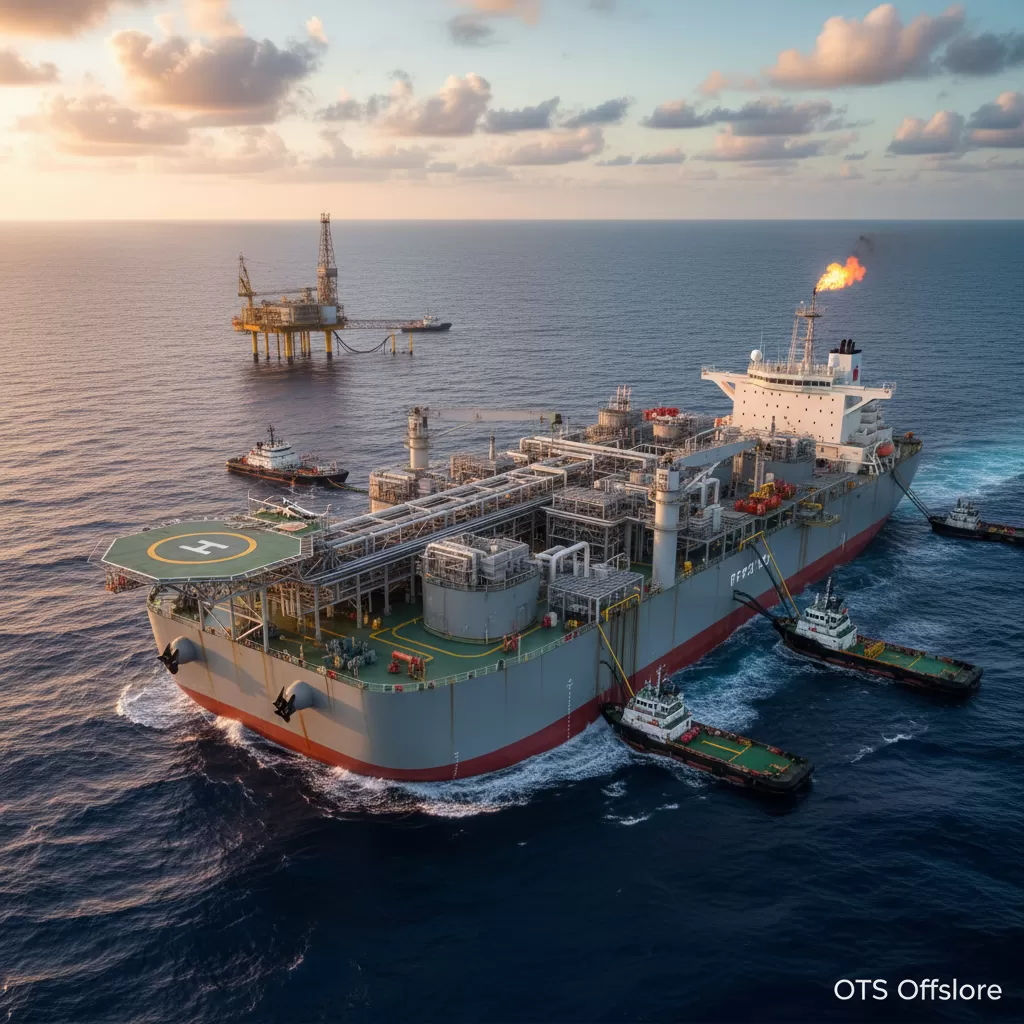The Concept and Role of Floating Production Storage and Offloading (FPSO) systems represent a pivotal advancement in offshore oil and gas exploration and production. These integrated marine facilities are designed to process, store, and offload hydrocarbons from subsea reservoirs, offering unparalleled flexibility and efficiency, particularly in deepwater and remote locations.
Understanding the Concept and Role of Floating Production Storage and Offloading (FPSO) in Modern Energy Extraction
The Concept and Role of Floating Production Storage and Offloading (FPSO) units are central to the evolving landscape of offshore hydrocarbon extraction. As exploration ventures push into increasingly challenging environments, the adaptability and self-sufficiency of FPSOs have cemented their position as indispensable assets. These sophisticated vessels combine the functions of a production facility, a storage tank, and an offloading terminal into a single, mobile platform, thereby streamlining operations and mitigating the complexities associated with traditional fixed infrastructure. Their capability to operate in deepwater, harsh weather conditions, and geographically remote areas makes them a cornerstone for unlocking previously inaccessible reserves. The intrinsic flexibility of FPSO units allows for redeployment to new fields after the depletion of an existing one, offering a significant return on investment and a sustainable approach to offshore resource management. This comprehensive analysis will delve into the fundamental concept of FPSOs, explore their multifaceted role in the energy sector, and highlight the key technological and operational considerations that define their significance.
The Core Concept of Floating Production Storage and Offloading (FPSO) Explained
At its heart, the concept of Floating Production Storage and Offloading (FPSO) is a marine vessel ingeniously designed to act as a self-contained offshore processing plant. Unlike fixed platforms that are permanently installed on the seabed, FPSOs are typically converted tankers or purpose-built ships. This fundamental difference grants them immense operational latitude. They are anchored or moored above a subsea oil or gas field, connecting to the reservoir via risers and flowlines. Once hydrocarbons are extracted from the seabed, they are piped up to the FPSO for processing. This processing can include separation of oil, gas, and water, as well as treating the crude oil to meet export specifications.
The “Storage” aspect of an FPSO refers to its inherent capacity to hold processed crude oil within its tanks. This buffer capability allows for continuous production even when offloading operations are not immediately underway, such as during adverse weather conditions or when shuttle tankers are en route.
The “Offloading” component signifies the critical function of transferring the stored crude oil to smaller shuttle tankers. These tankers then transport the oil to onshore terminals or refineries. This seamless transfer mechanism is a hallmark of FPSO operations, ensuring a consistent flow of valuable commodities to market.
The adaptability of the FPSO concept extends beyond its basic functions. Many FPSOs are equipped with gas compression and re-injection capabilities, allowing surplus gas to be returned to the reservoir for pressure maintenance, thereby enhancing overall field recovery. Some also incorporate facilities for water injection, further optimizing production. This integrated approach makes the FPSO a powerful tool for maximizing hydrocarbon recovery while minimizing environmental impact.
Key Components and Systems of an FPSO Vessel
An FPSO is a marvel of marine engineering, integrating numerous sophisticated systems to perform its complex functions. Understanding these components is crucial to appreciating the full scope of the FPSO’s role.
– Hull and Superstructure: The primary vessel structure provides buoyancy and stability, housing all processing equipment, living quarters, and storage tanks. Converted tankers, like Modified Very Large Crude Carriers (VLCCs), are common, but purpose-built hulls offer optimized layouts.
– Mooring System: This system secures the FPSO to the seabed. Options include turret mooring, spread mooring, and dynamic positioning. Turret systems allow the FPSO to weathervane into the prevailing environmental conditions, optimizing risers and mooring lines.
– Riser System: These flexible or rigid pipelines connect the subsea wellheads to the FPSO. They are designed to withstand significant movement of the vessel and the harsh marine environment.
– Processing Modules: These are topside units installed on the FPSO deck, responsible for separating oil, gas, and water, removing impurities, and conditioning the crude oil. They include separators, heat exchangers, filters, and dehydration units.
– Storage Tanks: Integrated within the hull, these tanks hold the processed crude oil before it is offloaded to shuttle tankers.
– Offloading System: This includes loading arms or flexible hoses that connect the FPSO to shuttle tankers for the transfer of crude oil.
– Utilities and Support Systems: These encompass power generation, accommodation for personnel, fire-fighting systems, wastewater treatment, and navigation equipment.

The Multifaceted Role of FPSOs in the Global Energy Sector
The significance of Floating Production Storage and Offloading (FPSO) units in the global energy sector cannot be overstated. They have evolved from niche solutions to indispensable workhorses, particularly in challenging offshore environments. Their role extends far beyond simply extracting oil and gas; they are enablers of complex projects and crucial contributors to energy security.
Facilitating Deepwater and Ultra-Deepwater Production
One of the most profound contributions of FPSOs is their ability to unlock hydrocarbon reserves located in deepwater and ultra-deepwater environments. Installing fixed platforms at such depths is often prohibitively expensive and technically challenging. FPSOs, with their inherent mobility and self-sufficiency, provide a cost-effective and practical solution. They can be deployed and redeployed as needed, making the economic viability of exploiting these remote resources significantly more attractive. This capability has opened up vast new frontiers for oil and gas exploration, significantly expanding the global recoverable reserves. The flexibility to operate in depths exceeding 2,000 meters showcases the advanced engineering and operational capabilities that FPSOs bring to the industry.
Enabling Production in Remote and Harsh Environments
Beyond depth, FPSOs are instrumental in fields located far from existing infrastructure or in regions characterized by harsh weather conditions. Their ability to withstand severe storms and operate autonomously reduces the reliance on complex subsea pipelines to shore, minimizing project risks and logistical complexities. This is particularly relevant in frontier exploration areas where the establishment of onshore facilities might not be immediately feasible. The self-contained nature of FPSOs ensures continuous operations, even when external conditions are unfavorable for conventional operations. This resilience is vital for maintaining a stable supply of energy from these challenging locales.
Enhancing Field Development Flexibility and Economics
The inherent mobility of FPSOs provides a level of flexibility that fixed platforms cannot match. Once a field is depleted, an FPSO can be disconnected, refurbished, and redeployed to a new prospect. This redeployment capability significantly enhances the return on investment for FPSO units, as their operational life is not tied to a single field. This adaptability allows for more agile field development strategies, enabling operators to optimize production profiles and respond to market changes more effectively. Furthermore, the integrated nature of FPSO systems can often lead to lower capital expenditure and operational expenditure compared to developing a field with multiple fixed structures and separate processing facilities.
Supporting Marginal and Subsea Tie-Back Developments
FPSOs also play a crucial role in the economic development of marginal fields and in supporting subsea tie-back projects. Smaller, economically marginal fields might not justify the cost of a dedicated fixed platform. An FPSO can serve as a central processing hub, receiving hydrocarbons from multiple subsea wells or even from nearby smaller fields via tie-back pipelines. This hub-and-spoke approach allows for the efficient and cost-effective exploitation of smaller reserves that might otherwise remain undeveloped. The FPSO’s ability to process and store production from these satellite fields makes them an attractive solution for maximizing overall hydrocarbon recovery from a region.
Mitigating Environmental Risks and Improving Safety
While offshore operations inherently carry risks, the design and operational protocols of modern FPSOs are heavily focused on safety and environmental protection. By processing and storing hydrocarbons onboard, FPSOs can reduce the need for extensive subsea pipelines, which are susceptible to leaks and damage. The integrated systems also allow for efficient management of produced water and gas, often enabling re-injection or treatment before discharge. The contained nature of the FPSO operations, coupled with advanced safety systems, contributes to a more controlled and safer operational environment compared to some older, more fragmented offshore production methods.
Technological Advancements and Future Trends in FPSO Design and Operation
The evolution of Floating Production Storage and Offloading (FPSO) technology is a continuous process, driven by the relentless pursuit of efficiency, safety, and sustainability in the offshore energy sector. Innovations are constantly being integrated to meet the demands of ever-deeper waters, more complex reservoir challenges, and a growing emphasis on environmental stewardship.
Innovations in Hull Design and Turret Technology
Recent advancements in hull design focus on improving stability in extreme weather conditions and optimizing deck space for larger processing modules. Purpose-built FPSO hulls are increasingly being designed with specific field requirements in mind, offering superior performance and cost efficiencies. Turret technology has also seen significant development, with improvements in swivel stack designs that enhance the reliability of fluid and power transfer between the fixed turret and the rotating vessel. Advanced mooring systems, including hybrid configurations combining taut lines and catenary systems, are being developed to enhance station-keeping capabilities in ultra-deepwater and harsh environments.
Enhanced Processing and Separation Technologies
The efficiency of the processing modules on an FPSO is paramount. Innovations in multiphase flow meters, advanced separation technologies (such as compact gravity separators and centrifugal separators), and compact heat exchangers are leading to smaller, lighter, and more energy-efficient processing trains. These advancements allow for higher processing capacities within a given footprint and can improve the quality of the produced oil and gas. Furthermore, enhanced gas dehydration and compression technologies are enabling more effective utilization of associated gas, including its re-injection for enhanced oil recovery or its liquefaction for export.
Digitalization, Automation, and Remote Operations
The integration of digital technologies is transforming FPSO operations. The adoption of advanced process control systems, real-time monitoring of equipment health, and the use of artificial intelligence (AI) for predictive maintenance are becoming increasingly prevalent. These digital solutions enable operators to optimize production, reduce downtime, and enhance safety through remote monitoring and diagnostics. The development of autonomous or remotely operated FPSOs, with reduced onboard personnel, is a significant future trend, aimed at further improving safety and reducing operational costs in challenging environments.
Focus on Environmental Performance and Decommissioning
There is a growing emphasis on minimizing the environmental footprint of FPSOs. This includes developing more efficient systems for produced water treatment, reducing greenhouse gas emissions through improved energy efficiency and carbon capture technologies, and designing FPSOs for easier decommissioning at the end of their lifecycle. Modular designs that facilitate the removal and recycling of components are gaining traction. The industry is actively exploring solutions for responsible field abandonment and the repurposing or recycling of FPSO hulls.
The Rise of FPSOs in Floating Liquefied Natural Gas (FLNG) and Other Applications
While traditionally associated with crude oil production, the FPSO concept is being adapted for other offshore energy applications. Floating Liquefied Natural Gas (FLNG) facilities, which process natural gas at sea and liquefy it for transport via specialized LNG carriers, represent a significant evolution. These FLNG units share many operational similarities with oil production FPSOs, demonstrating the versatility of the floating facility concept. Other potential applications include floating storage and regasification units (FSRUs) for the import of liquefied natural gas. The fundamental principles of a self-contained floating processing and storage unit are proving adaptable to a broader range of energy needs.








